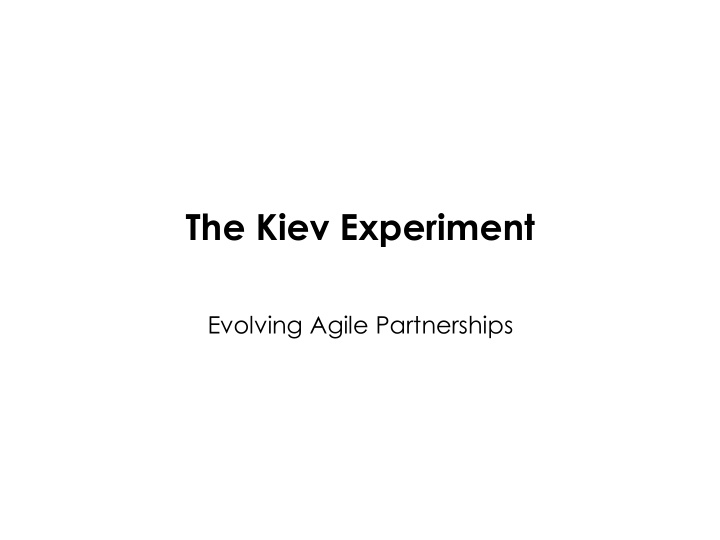



The Kiev Experiment Evolving Agile Partnerships
Who are we? • Simon Ogle • Alexander Kikhtenko • Peter Thomas
Where did we start? • Existing monolithic mainframe application • Quarterly deliveries • 6 week testing cycles • Offshore delivery teams • Waterfall process • Command and control
What did we want to do? • Belief there was a better way to deliver software • Incremental development to deliver business value quickly • Address the rapidly changing business landscape with flexibility in delivery • Build quality into the solutions • Deliver the software rapidly, but in a cost effective manner • Put the fun back into software delivery • But the rest of the organisation very sceptical about our delivery approach
How did we start? • Started with a single team in London • Initially focused on building the tools, proving the processes and technologies • Release 1.0 on Friday 13 th October 2006 • Very soon we started to look how we could scale
Where are we now? • 5 years into the delivery • 2M trades per day • 100 billions settling per day in all major currencies • 40 exchanges across EMEA and APAC • 15 scrum teams/120 people • Teams in London, Kiev, Hyderabad, Hong Kong and New York • 9 application components • Production releases every 2 weeks
Evolving the team Evolving the relationship
D D D D D D D 2006 small co-located team
D D D D D D D D D D D D D 2006 2007 small co-located team
D D D D D D D D D D D D D 2006 2007 small co-located component team teams
D D D D D D A T D D D D D A T D D D D D A T 2006 2007 2008 2009 small co-located component co-located dispersed team teams feature teams feature teams
D D D D D D A T D D D D D D D A T A T D D D D D A T 2006 2007 2008 2009 2010 small co-located component co-located dispersed first distributed team teams feature teams feature teams feature team
D D D D D D D D D D A T A T D D D D D D D D D A T A T D D D D D D D D A T A T 2006 2007 2008 2009 2010 2011 small co-located component co-located dispersed first distributed many distributed team teams feature teams feature teams feature team feature teams
New York London Kiev Hyderabad Hong Kong
Evolving the communication
Communication issue Offshore team 1 Analysts End users Offshore team 2 Architects Offshore team 3
Broadening communication bandwidth
Polycom experiment PHOTO Communication flow
Skype and projector
Interactive whiteboards + Skype
TelePresence?
Bridging the communication gap
Team intermediary Onshore team Intermediary Offshore team
Bilateral rotation
Specification by example
SBE over Smartboard
Dedicated architects group Offshore team 1 Offshore Architects team 2 Offshore team 3
Joint architecture workshops
Joint architecture workshops
Luxoft teams evolution 30 people 4 teams 21 people 3 teams 6 people 1 team May 2010 User stories Dec 2009 4 people 0 teams refined in User stories collaboration refined by SME May 2009 with end users Complex technical tasks Jan 2009 Small pieces of technical tasks
Tackling technical challenges
Release management Release 1.0 Release 2.0 trunk
But how do you scale? Release 1.0 Release 2.0 trunk Multiple Concurrent teams projects
Let’s introduce a process Release 2.1 Release 2.0 ISE CHIX TQ
Manual and high coordinated Waste of delayed integration CI needed on each branch But what if this now becomes the highest priority?
How do you address How do you allow How can you have an changing feature incremental feature agile release function? priority? development?
This is what we want Release X Release Y (ISE) (CHIX) ISE CHIX trunk TQ
Latent Code Patterns Release X Release Y (ISE) (CHIX) ISE CHIX trunk TQ “One of the most powerful techniques I have used over the last three years is latent code patterns.” Chris Matts InfoQ – The Last Responsible Moment in Deployment
Latent Code Patterns Release X Release Y (ISE) (CHIX) ISE CHIX trunk TQ Event Driven Feature Bits or Configuration Modularity or Dependency Injection
Keeping it green 200 commits per day 1000 artefacts updated per day 1 commit every 5 minutes peak
A single bad commit …
A wasted day 13 hours elapsed time wasted 500 hours of effort wasted
Coaching
Fast visible feedback • 24 Build Targets • 37 Test Targets
So how did we get here? • Protect the team and empower them • Go and see • Embrace “muddling through” • Don’t accept the status quo – have courage • Follow through with change – be tenacious • Respect and trust people • Invest in the engineering • Stop worrying about big – make it small
Recommend
More recommend